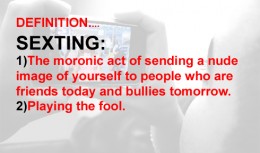 Sexting is in the news again with a study that showed 1 in 4 Texas teens had engaged in sexting. Sexting was defined in the study as not flirting or sharing an image partially clothed – but sending nude images.
Sexting is in the news again with a study that showed 1 in 4 Texas teens had engaged in sexting. Sexting was defined in the study as not flirting or sharing an image partially clothed – but sending nude images.
New Jersey passed a sexting law in 2011 that decriminalized sext’d images so that children were not being prosecuted for producing child pornography. The law allows for first-time offender status in order to avoid becoming a registered sex offender.
But the problem of sexting remains an issue in New Jersey, and a concern for parents state wide and locally. Recently, a Wisconsin college student was arrested for luring a 9 year old Wyckoff girl into sexting images of herself.
But comparing Texas to the rest of the nation might not necessarily provide an accurate portrayal of the sexting epidemic. Texas, while showing significant improvement, continues to be one of America’s leaders in terms of the percentage of teen pregnancies. Teen pregnancy statistics provides a commonsense comparison in terms of common sense behavior, and it’s logical to conclude that careless and reckless behavior is not isolated to sexting or unsafe sex.
The recent study of Texas high school students indicated that those who engage in sexting were more likely to be, or become, sexually active. The survey was a focused study that did not address the social ramifications in terms of peer humiliation and ridicule as the digital images are shared; nor did it address the long term implications of job and college applications being denied.
The Centers For Disease Control and Prevention offers an online database called the Youth Risk Behavior Surveillance System. It provides statistics gathered from individual states on a variety of subjects that cover both positive and risky behavior of America’s youth broken down by state. It also offers a feature to compare states, and in conservative Texas – things are a bit more wild than in wild, Snookie New Jersey.
The CDC state comparison tool of American teens covers a wide range of subjects that include sexual activity, bullying, diet, exercise, mental health, and drug and alcohol use.
New Jersey basically falls in line with the traditionally conservative New England states, along with regions like North Dakota and Minnesota, all of which have some of the lowest teen pregnancy rates in the country.
This does not mean NJ parents should be lax in maintaining open lines of communication, and they should continue to take an active interest in their children’s online & digital activities. TheNationalCampaign.org, focused on reducing teen pregnancies, offers suggestions and advice for both parents and teens on a variety of subjects that includes dealing with technology – Sex Tech. The Sex Tech survey is another very useful resources available in PDF by clicking here.
While the overall positive behavior of teens today displays a greater sense of responsibility than found in previous years, there are other areas where sexting practices is indicative of growing safety and health concerns for America’s youth. For example, young people age 15-24 represent only 25% of the sexually active population of the United States – and yet they are responsible for 50% of the sexually transmitted diseases reported.
It should come as no surprise to parents that children today are more cognizant of their sexuality than in previous generations. This is not entirely due to the explosion of pornography and sexually explicit images available on the Internet, but also the mainstream sexualization of children in marketing.
A 2011 study out of the Univeristy of Ohio found that 30% of girls’ clothing for sale at 15 major retailers had sexualizing characteristics. A 2007 task force found that girls who buy into sexualizing media messages are more likely to experience low self-esteem, depression and eating disorders….Sexting is only one new danger parents need to educate and warn their children about.
